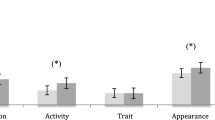Abstract
College students' perceptions of the ideal female, ideal male, and self-portrayal were studied using the Bem Sex Role Inventory. Males and females described themselves and their ideals with regard to sex-typed masculine and feminine characteristics. Females described an androgynous model for themselves and their ideal. Males described an androgynous model for their self-portrayal, but sex-typed portrayals for their ideal male and ideal female. The implication of males' inconsistent pattern of responding is discussed.
Similar content being viewed by others
References
Bem, S. L. The measurement of psychological androgyny. Journal of Consulting and Clinical Psychology, 1974, 42, 155–162.
Bem, S. L. On the utility of alternative procedures for assessing psychological androgyny. Journal of Consulting and Clinical Psychology, 1977, 45, 196–205.
Broverman, I., Broverman, D., Clarkson, F., Rosenkrantz, P., & Vogel, S. Sex-role stereotypes and clinical judgments of mental health. Journal of Consulting and Clinical Psychology, 1970, 34, 1–7.
Broverman, I., Vogel, S., Broverman, D., Clarkson, F., & Rosenkrantz, P. Sex-role stereotypes: A current appraisal. Journal of Social Issues, 1972, 28, 59–78.
Downing, N. Theoretical and operational conceptualizations of psychological androgyny: Implications for measurement. Psychology of Women Quarterly, 1979, 3, 284–292.
Komarovsky, M. Cultural contradictions and sex roles: The masculine case. American Journal of Sociology, 1973, 78, 873–884.
Kravetz, D. Consciousness-raising groups in the 1970's. Psychology of Women Quarterly, 1978, 3, 168–186.
Lieberman, M., & Bond, G. The problem of being a woman: A survey of 1,700 women in consciousness-raising groups. Journal of Applied Behavioral Science, 1976, 12, 363–379.
O'Leary, V., & Depner, C. College males' ideal female: Changes in sex-role stereotypes. Journal of Social Psychology, 1975, 95, 139–140.
Rosenkrantz, P. S., Vogel, S. R., Bee, H. Broverman, I. K., & Broverman, D. M. Sex role stereotypes and self concepts in college students. Journal of Consulting and Clinical Psychology, 1968, 32, 287–295.
Sedney, M. A. Comment on median split procedures for scoring androgyny measures. Sex Roles, 1981, 7, 217–222.
Spence, J. T., Hemreich, R., & Stapp, J. Ratings of self and peers on sex-role attributes and their relation to self-esteem and conceptions of masculinity and femininity. Journal of Personality and Social Psychology, 1975, 32, 29–39.
Steinmann, A., & Fox, D. Male-female perceptions of the female role in the United States. Journal of Psychology, 1966, 64, 265–276.
Warren, L. The therapeutic status of consciousness-raising groups. Professional Psychology, 1976, 7, 132–140.
Author information
Authors and Affiliations
Rights and permissions
About this article
Cite this article
Scher, D. Sex-role contradictions: Self-perceptions and ideal perceptions. Sex Roles 10, 651–656 (1984). https://doi.org/10.1007/BF00287272
Issue Date:
DOI: https://doi.org/10.1007/BF00287272




